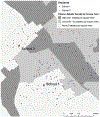Tobacco Retail Density and Initiation of Alternative Tobacco Product Use Among Teens
- PMID: 31784411
- PMCID: PMC7089810
- DOI: 10.1016/j.jadohealth.2019.09.004
Tobacco Retail Density and Initiation of Alternative Tobacco Product Use Among Teens
Abstract
Purpose: The rise of noncigarette, alternative tobacco product (ATP) use among adolescents may be due in part to an increase in retail availability of ATPs. We examined whether proximity and density of tobacco retailers near students' homes are associated with a higher likelihood of initiating ATP use over time.
Methods: Using data from 728 adolescents (aged 13-19 years at baseline) residing in 191 different neighborhoods and attending 10 different California high schools, longitudinal multilevel and cross-classified random effect models evaluated individual-level, neighborhood-level, and school-level risk factors for ATP initiation after 1 year. Covariates were obtained from the American Community Survey and the California Department of Education.
Results: The sample was predominantly female (63.5%) and was racially and ethnically diverse. Approximately one third of participants (32.5%) reported ever ATP use at baseline, with 106 (14.5%) initiating ATP use within 1 year. The mean number of tobacco retailers per square mile within a tract was 5.66 (standard deviation = 6.3), and the average distance from each participant's residence to the nearest tobacco retailer was .61 miles (standard deviation = .4). Living in neighborhoods with greater tobacco retailer density at baseline was associated with higher odds of ATP initiation (odds ratio = 1.22, 95% confidence interval = 1.07-2.12), controlling for individual and school factors.
Conclusions: Tobacco retailers clustered in students' home neighborhood may be an environmental influence on adolescents' ATP use. Policy efforts to reduce adolescent ATP use should aim to reduce the density of tobacco retailers and limit the proximity of tobacco retailers near adolescents' homes and schools.
Keywords: Adolescents; Alternative tobacco products; E-cigarettes; Neighborhoods; Schools; Tobacco retail environment; Tobacco retailer; Young adults.
Copyright © 2020 Society for Adolescent Health and Medicine. Published by Elsevier Inc. All rights reserved.
Conflict of interest statement
Figures
Comment in
-
Retail Outlets and Point-of-Sale Marketing of Alternative Tobacco Products: Another Threat to Tobacco Control.J Adolesc Health. 2020 Apr;66(4):385-386. doi: 10.1016/j.jadohealth.2020.01.001. J Adolesc Health. 2020. PMID: 32199518 No abstract available.
References
-
- National Center for Chronic Disease, P., Health Promotion Office on, S. & Health. in The Health Consequences of Smoking-50 Years of Progress: A Report of the Surgeon General (Centers for Disease Control and Prevention (US), 2014).
-
- Vuong TD, Z. X., Roeseler A. California Tobacco Facts and Figures 2019. (California Department of Public Health, Sacramento, CA:, May 2019). https://www.cdph.ca.gov/Programs/CCDPHP/DCDIC/CTCB/CDPH%20Document%20Lib...
-
- Schleicher N, J. T., Rigdon J, Kaimal R, Desai M, Ababseh K, Henriksen L California Tobacco Retail Surveillance Study (2017). https://www.cdph.ca.gov/Programs/CCDPHP/DCDIC/CTCB/CDPH%20Document%20Lib...


